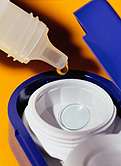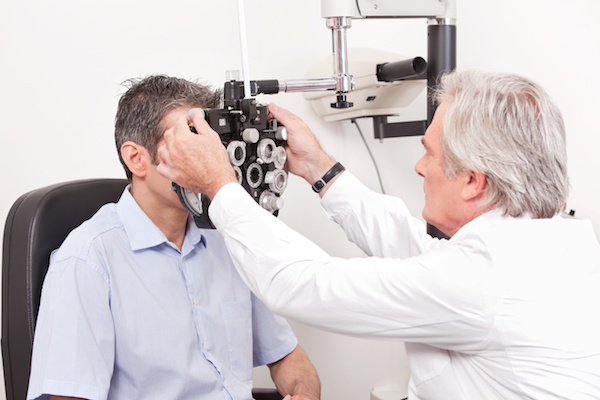
WEDNESDAY, March 24 (HealthDay News) — A team of researchers has created special contact lenses for glaucoma patients that come loaded with vitamin E, using a design that could essentially lengthen the amount of time a medication bathes an afflicted eye.
This strategy could reduce the significant waste of medication that happens with traditional eye drops, but so far the concept has only been tested in beagles.
“Currently, the way we deliver medication to the eye is very bad and very ineffective,” said study author Anuj Chauhan, an associate professor in the department of chemical engineering at the University of Florida in Gainesville. “And this approach is wonderful because it delivers drugs for a long period of time.”
Chauhan and his colleagues are to present their findings Wednesday at the American Chemical Society annual meeting in San Francisco.
According to the Glaucoma Research Foundation, glaucoma starts as a symptom-less disease that, through damage to the optic nerve, can ultimately rob a patient of his or her sight. The disease accounts for approximately 9 percent to 12 percent of all blindness in the United States, and the World Health Organization notes that it is the second leading cause of blindness worldwide.
There is no cure for the estimated 4 million Americans who have the disease, and once vision is lost, it cannot be restored. However, treatments — including medicine and surgery — do slow down or halt disease progression.
Vitamin E is thought to aid vision because of its antioxidant capacities, and several studies have already explored the notion that it could help combat glaucoma when used in conjunction with prescription drugs.
The current research focused on contact lenses that can be worn for up to a month.
The authors note that their study has already revealed that contacts pre-loaded with vitamin E can extend drug-delivery duration by upwards of 100 times when compared with regular commercial lenses. Delivery of medications via eye drops only exposes the eye to two to five minutes of treatment, they added.
Human trials to test the approach are still one to two years away, Chauhan said. But he added that, if successful, this drug-delivery method could have multiple applications beyond the goal of improving glaucoma treatment.
“This could have significant benefits for several millions of patients, from both a therapeutic angle and a prevention angle,” he said. “Because not only could it provide better drug relief for glaucoma, but it could potentially address a number of other eye diseases, such as cataracts and dry eye. And the neutroceuticals of vitamin E also block UV light exposure.”
“But what will actually work out in the future only time will tell,” Chauhan cautioned.
Meanwhile, Dr. Alfred Sommer, a professor of ophthalmology and dean emeritus at the Bloomberg School of Public Health at Johns Hopkins University in Baltimore, expressed some reservations about the approach.
“A delivery mechanism to essentially bathe the eye in slow and continuous medication to target a whole range of diseases from macular degeneration to glaucoma has been a holy grail for ophthalmology for many years,” he noted. “But by and large the efforts to do this have not proven successful, although it would certainly be nice to have.”
“But since the most effective glaucoma drops we have today you only have to put in once a day, the question then is, would people really put a contact lens in their eye when they don’t really otherwise use contacts?” Sommer asked. “That is speculative, particularly when we strongly advise contact lens wearers never to wear a lens overnight. So, it’s not immediately apparent to me what the advantages would be for glaucoma.”
At the same meeting, a research team out of Iowa State University is scheduled to report Wednesday on a new technology that might be able to catch glaucoma in its pre-symptomatic, early stages.
Led by Iowa State assistant professor Chenxu Yu, the team said they believe they are on the verge of a diagnostic “breakthrough” with the aid of infrared laser light — via a method called “Raman spectroscopy” — that shines through the eye’s pupil to take a “snapshot” of the retina. They hope the high-tech picture could one day be used to identify biochemical signs of glaucoma in its infancy.
More information
For more on glaucoma, visit the Glaucoma Research Foundation.

